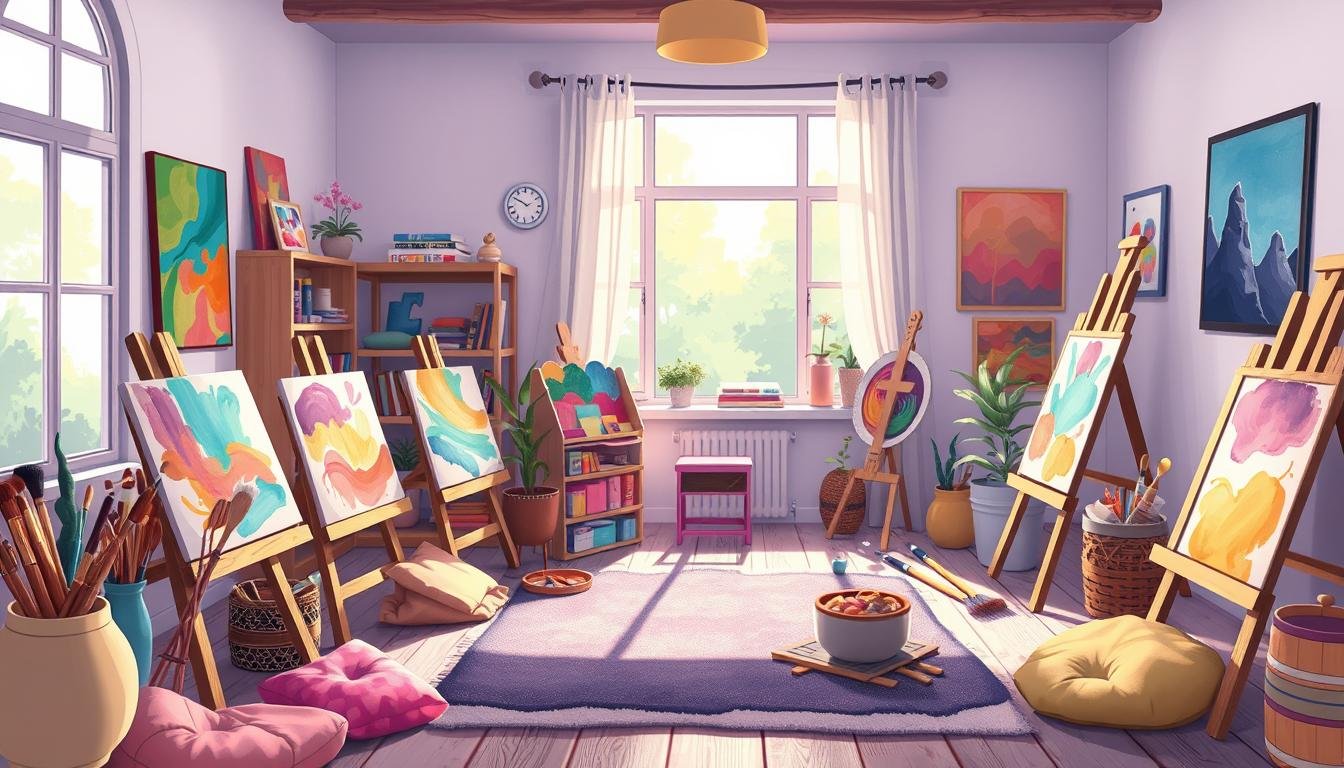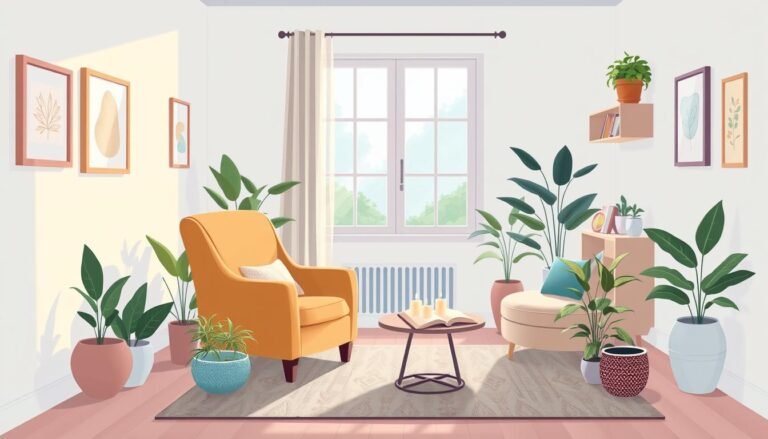Discover the Power of Expressive Arts Therapy
Have you ever thought about how art can heal more than just your soul? Expressive Arts Therapy is a powerful way to heal through Self-Expression. It uses different art forms to unlock your inner strength and improve your well-being.
This therapy has roots in ancient practices and is now recognized worldwide. It combines movement, visual arts, music, and writing. This helps you grow and heal on many levels, like your senses, emotions, and thoughts.
Research shows that Expressive Arts Therapy has many benefits. It can reduce PTSD symptoms and even improve your health. It can also help you do better in school, feel better about yourself, and even prevent suicide.
Imagine a therapy that helps you deal with emotions and inspires you to take positive steps. That’s what Expressive Arts Therapy offers. It’s not just about making art; it’s about becoming a healthier, happier version of yourself.
Understanding Expressive Arts Therapy
Expressive Arts Therapy is a healing method that uses different creative ways. It helps people express their feelings, thoughts, and experiences through art.
Origins and Historical Development
The history of Expressive Arts Therapy started in the 1970s at Leslie College Graduate School in Cambridge, Massachusetts. In 1984, Paolo Knill founded the International Network of Expressive Arts Therapy Training Centers. This was a big step forward for the field.
Core Principles and Philosophy
At its heart, Expressive Arts Therapy is about exploring inside and releasing emotions. It believes that making art can lead to personal growth and building communities. It sees the artistic process as a way to discover oneself, blending body, mind, and emotions.
- Multimodal approach combining visual arts, movement, drama, music, and writing
- Emphasis on the process rather than artistic skill
- Integration of mind-body connection
Integration with Traditional Psychotherapy
Expressive Arts Therapy works well with traditional talk therapy. It gives a way to express feelings without words. This mix helps treat mental health in a more complete way, tackling hard-to-say issues.
| Therapeutic Modality | Benefits |
|---|---|
| Art Therapy | Addresses emotions, thoughts, experiences through visual arts |
| Dance Therapy | Manages anxiety, stress, depression through movement |
| Music Therapy | Enhances mood, reduces anxiety |
| Writing Therapy | Explores thoughts and emotions through journaling, poetry |
By mixing these creative methods with traditional therapy, Expressive Arts Therapy offers a special way to heal and find oneself. It’s a valuable tool in the mental health world.
The Creative Connection in Therapeutic Healing
Expressive Therapies use creative arts to heal. They tap into self-expression and emotional release. This offers a holistic path to wellness.
Movement and Dance Expression
Dance and movement in Creative Arts Therapy unlock deep emotions. They allow people to express feelings that words can’t. This physical expression leads to emotional breakthroughs.
Visual Arts and Emotional Release
Visual arts are powerful for emotional exploration. Painting, drawing, or sculpting makes internal struggles tangible. This creative process helps in self-discovery and healing.
Music and Sound Therapy
Music therapy uses sound to heal. It can evoke strong emotions and memories. This form of therapy promotes emotional release and growth.
Writing and Poetry as Healing Tools
Writing and poetry offer a creative outlet for self-expression. In Expressive Therapies, they provide a safe space for exploring thoughts and feelings. This often leads to deep insights and healing.
| Creative Art Form | Therapeutic Benefits | Emotional Impact |
|---|---|---|
| Movement/Dance | Body awareness, stress relief | Release of pent-up emotions |
| Visual Arts | Self-expression, mindfulness | Externalization of internal struggles |
| Music/Sound | Mood regulation, memory recall | Evocation of deep emotions |
| Writing/Poetry | Cognitive processing, reflection | Structured emotional exploration |
The Person-Centered Expressive Arts training program has been running for over 30 years. It combines various therapeutic approaches. It welcomes professionals from all fields, with no art experience needed. This program promotes personal growth and creativity in a safe, non-judgmental space.
Benefits of Creative Arts in Mental Health
Creative arts therapy is a powerful tool for healing and emotional release. It combines art with traditional treatments to help those with mental health issues. This approach offers many benefits for those struggling with different conditions.
Studies show that creative activities boost mental health. A study found that spending 45 minutes a day on art lowers stress. Art therapy also improves thinking, self-esteem, and emotional strength.
Art lets people express feelings that are hard to say out loud. This can lead to deep insights and personal growth. For example, cancer patients in art therapy felt less negative and more positive.
| Mental Health Condition | Benefit of Creative Arts Therapy |
|---|---|
| Depression | Improved mood and reduced symptoms |
| Anxiety | Decreased stress and increased relaxation |
| PTSD | Enhanced emotional processing and trauma healing |
| Dementia | Improved cognitive function and memory recall |
The American Art Therapy Association says creative arts help with thinking, emotions, and confidence. These benefits help many, including kids who have been through trauma and older adults at risk of memory loss.
The Science Behind Expressive Arts Therapy
Expressive arts therapy is becoming more recognized as a powerful tool in treating mental health. Recent studies have shown its effectiveness in psychotherapy and holistic healing.
Neuroscience Research and Findings
Studies reveal that art therapy activates the brain’s reward system, releasing dopamine. This is similar to the feelings we get from eating or laughing. It’s especially helpful for those with anxiety, depression, or ADHD.
Brain scans have found differences in people with conditions like schizophrenia and autism. This shows how expressive therapies can target these issues.
Mind-Body Connection
The mind-body connection is central to expressive arts therapy. Mindfulness, a key part of art therapy, helps reduce stress. It focuses on the present moment.
This is especially beneficial for trauma survivors. It gives them a way to express and heal without words.
Evidence-Based Outcomes
Research backs up the success of expressive therapies in many areas. A study on mindfulness-based art therapy for women with cancer showed good results. It also helped in treating schizophrenia and other mental health issues.
As more research comes in, expressive arts therapy is proving to be a valuable part of mental health care. It’s a key part of holistic healing approaches.
Source Links
- Natalie Rogers Article Expressive Arts Therapy
- The Rise of Expressive Therapies
- When Words Aren’t Enough: The Power of Expressive Arts in Healing
- What Is Expressive Arts Therapy?
- Frequently Asked Questions
- Expressive Arts Therapy
- Person-Centered Expressive Arts
- From Therapeutic Factors to Mechanisms of Change in the Creative Arts Therapies: A Scoping Review
- Role of Art Therapy in the Promotion of Mental Health: A Critical Review
- Home
- Healing Through Art
- The Science Behind Art Therapy: A Creative Treatment Option
- Where art meets neuroscience: a new horizon of art therapy








